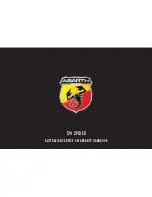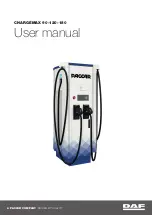
correct tightness of each lug nut is 100 ft/lb. (135 N. m).
If in doubt about the correct tightness, have them
checked with a torque wrench by your dealer or at a
service station.
7. For vehicles equipped with center caps, install the
center cap by hand. Do not use a hammer or excessive
force to install the center cap.
8. Stow the jack, tools, and spare tire. Make sure the base
of the jack faces the rear of the vehicle before tightening
down the fastener.
WARNING!
A loose tire or jack thrown forward in a collision or
hard stop could endanger the occupants of the ve-
hicle. Always stow the jack parts and the spare tire in
the places provided.
JUMP-STARTING PROCEDURES
WARNING!
•
Take care to avoid the radiator cooling fan whenever the hood is
raised. It can start anytime the ignition switch is on. You can be hurt
by the fan.
•
Do not attempt to push or tow your vehicle to get it started. Vehicles
equipped with an automatic transmission cannot be started this
way. Unburned fuel could enter the catalytic converter and once the
engine has started, ignite and damage the converter and vehicle. If
the vehicle has a discharged battery, booster cables may be used to
obtain a start from another vehicle. This type of start can be
dangerous if done improperly, so follow this procedure carefully.
•
Battery fluid is a corrosive acid solution; do not allow battery fluid
to contact eyes, skin, or clothing. Don’t lean over battery when
attaching clamps or allow the clamps to touch each other. If acid
splashes in eyes or on skin, flush contaminated area immediately
with large quantities of water.
•
A battery generates hydrogen gas, which is flammable and explo-
sive. Keep flame or spark away from the vent holes.
•
Do not use a booster battery or any other booster source with an
output that exceeds 12 volts.
•
The battery in this vehicle has a vent hose that should not be
disconnected and should only be replaced with a battery of the
same type (vented).
WHAT TO DO IN EMERGENCIES
373
6
Summary of Contents for 2008 LX49 Magnum
Page 2: ......
Page 5: ...INTRODUCTION 5 1...
Page 8: ......
Page 80: ......
Page 111: ...UNDERSTANDING THE FEATURES OF YOUR VEHICLE 111 3...
Page 112: ...112 UNDERSTANDING THE FEATURES OF YOUR VEHICLE...
Page 113: ...UNDERSTANDING THE FEATURES OF YOUR VEHICLE 113 3...
Page 157: ...Load Floor Handle Load Floor Partially Folded UNDERSTANDING THE FEATURES OF YOUR VEHICLE 157 3...
Page 166: ......
Page 172: ...BASE INSTRUMENT CLUSTER 172 UNDERSTANDING YOUR INSTRUMENT PANEL...
Page 173: ...PREMIUM INSTRUMENT CLUSTER IF EQUIPPED UNDERSTANDING YOUR INSTRUMENT PANEL 173 4...
Page 255: ...UNDERSTANDING YOUR INSTRUMENT PANEL 255 4...
Page 310: ...310 STARTING AND OPERATING...
Page 358: ......
Page 369: ...Jack Engagement Locations WHAT TO DO IN EMERGENCIES 369 6...
Page 380: ......
Page 448: ......
Page 458: ......
Page 459: ...INDEX 10...
















































